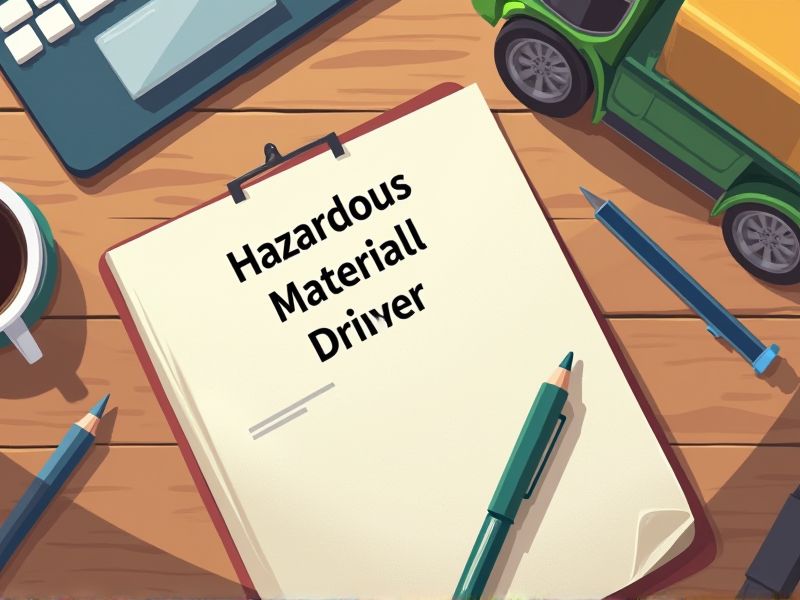
Transportation of hazardous materials requires compliance with stringent safety regulations to prevent accidents and mitigate environmental risks. Drivers must possess specific certifications to demonstrate their understanding and capability to handle such materials under varying conditions. Regulatory agencies mandate these certifications to ensure public safety and protect the transportation infrastructure. Some important certifications required for a Hazardous Materials Transportation Driver include the Hazmat Endorsement and Transportation of Dangerous Goods (TDG) certification.
Commercial Driver License (CDL) with HazMat Endorsement
A CDL with a HazMat endorsement ensures drivers can safely handle and transport dangerous materials, as it provides extensive training specific to hazardous material protocols. Regulatory compliance requires that drivers possess this endorsement to minimize risks associated with the transportation of hazardous goods. This endorsement, supported by a thorough background check, contributes to public safety by ensuring that only qualified individuals are responsible for such critical responsibilities. The specialized knowledge and skills acquired through this credential ensure the driver can respond effectively in emergencies involving hazardous materials.
Hazardous Materials Transportation Certification
Hazardous Materials Transportation Certification ensures that drivers possess the knowledge to handle dangerous substances safely, reducing risk of accidents. Proper training equips them to respond effectively to spills or leaks, minimizing environmental and health impacts. Regulatory compliance mandates certification for legal transport of hazardous materials, avoiding penalties and legal issues. Certification instills confidence among clients and the public, enhancing the reliability of transportation services.
Transportation of Dangerous Goods (TDG) Certification
Transportation of Dangerous Goods (TDG) Certification ensures drivers understand the specific regulations and procedures necessary to safely transport hazardous materials, minimizing the risk of accidents. This certification equips drivers with knowledge on emergency response tactics, which reduces the potential harm to the public and environment during incidents. Regulatory compliance is achieved through TDG Certification, allowing companies to avoid legal penalties and ensuring the smooth operation of their logistics processes. Certification helps improve public trust in transportation companies by demonstrating their commitment to safety and responsibility.
OSHA 10/30-Hour Training Certification
OSHA 10/30-Hour Training Certification ensures drivers grasp essential safety standards, reducing the risk of accidents during hazardous materials transportation. The certification educates drivers on handling materials properly, which prevents potential spills and contamination incidents. Familiarity with OSHA guidelines empowers drivers to identify and respond to hazards swiftly, ensuring public safety. Employers rely on trained drivers to maintain compliance with industry regulations, avoiding penalties and liability issues.
HAZWOPER (Hazardous Waste Operations and Emergency Response) Certification
HAZWOPER certification ensures drivers comprehend safety protocols when transporting hazardous materials, reducing the risk of accidents and exposure. The training enhances their capability to manage emergency situations effectively, minimizing harmful environmental impacts. Certified drivers demonstrate compliance with federal regulations, which helps avoid costly penalties and legal repercussions. Employers benefit from having certified drivers by maintaining a safer work environment and improving their safety track record.
Security Awareness Training Certification
Security Awareness Training Certification is necessary to ensure that drivers of hazardous materials understand potential threats and vulnerabilities. This certification helps them recognize and respond to security risks, reducing the likelihood of accidents or incidents. Regulatory compliance often mandates this training to align with industry safety standards. Without such certification, the risk of hazardous material mishandling increases, potentially causing environmental harm or safety breaches.
Emergency Response Training Certification
Emergency Response Training Certification equips drivers with the necessary skills to safely manage hazardous materials during transit, reducing accident risks. Regulatory compliance mandates certification to ensure all drivers can effectively handle potential spills or leaks. Proper training enhances quick decision-making in crisis situations, minimizing harm to public and environment. Liability and financial risks decrease for companies when certified personnel manage hazardous materials.
First Aid and CPR Certification
First Aid and CPR certification for hazardous materials transportation drivers increases the likelihood of survival and recovery in cases of accidental chemical exposure or related health emergencies. Training equips drivers with the necessary skills to respond quickly and efficiently, minimizing potential health impacts from exposure to hazardous substances. Certification helps ensure compliance with transportation safety regulations, thereby reducing legal liabilities for both drivers and their employers. Properly trained drivers contribute to overall public safety by being prepared to act in emergencies, thus fostering a safer transportation environment.
Defensive Driving Certification
Hazardous materials transportation drivers require a Defensive Driving Certification because it enhances their ability to anticipate and react to road hazards, reducing the risk of accidents. Certification courses impart critical safety techniques tailored to the unique challenges of transporting sensitive and potentially dangerous cargo. Regulatory bodies often mandate such certifications to ensure compliance with industry safety standards and minimize public safety threats. Completion of defensive driving programs frequently results in fewer incidents, leading to lower insurance costs and increased operational efficiency.
Transportation Worker Identification Credential (TWIC)
The TWIC is essential because it enhances security by ensuring that individuals with unescorted access to secure areas are not a security threat. Its requirement helps prevent unauthorized access to hazardous materials, which could otherwise be used for harmful purposes. The credential ensures that drivers have undergone a thorough background check, reinforcing trust in their handling of sensitive cargo. Compliance with maritime and transportation security laws is achieved as TWIC aligns with state and federal regulations.
Summary
When you obtain certifications as a Hazardous Materials Transportation Driver, your employability significantly increases as companies prioritize certified professionals for safety assurance. Enhanced skills from certification training lead to fewer accidents and incidents on the job. Insurance premiums for companies employing certified drivers often decrease due to a lowered risk profile. Career advancement opportunities expand as certified drivers become eligible for higher responsibility routes and leadership roles.
